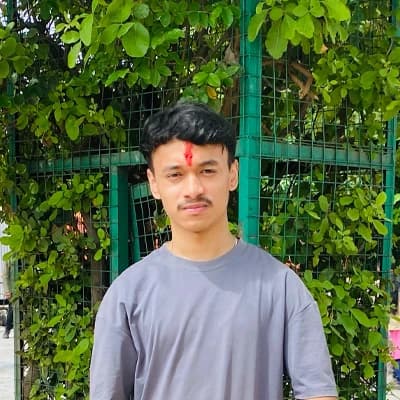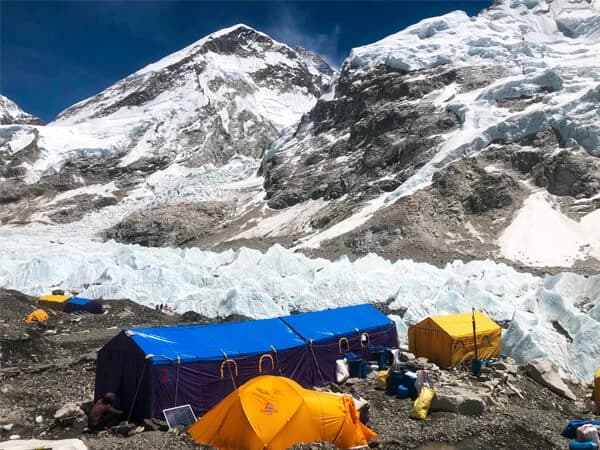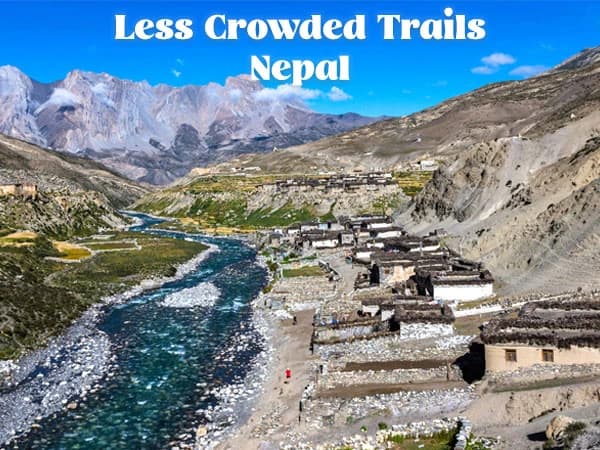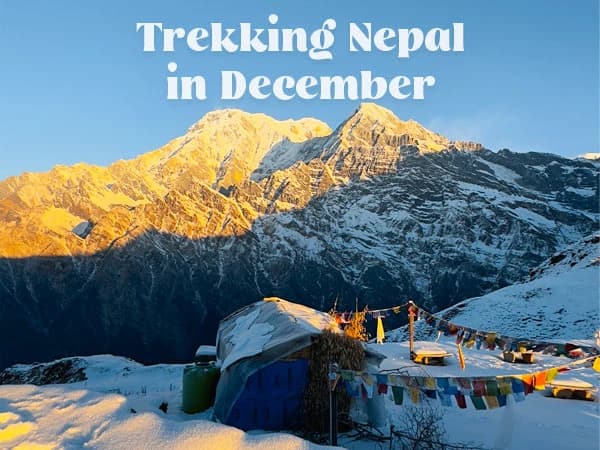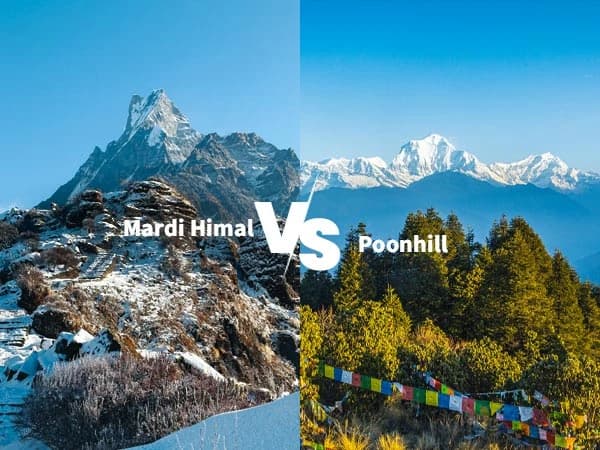Why is the Everest Base Camp Trek unique?
Everest Base Camp trek is highly sought after and draws a lot of trekkers every year to the foot of the highest mountain in the world. It provides stunning scenery of high mountains, a rich Sherpa culture, and the possibility of seeing the routes of popular climbers. The trek also provides you with an excellent sense of accomplishment that lingers well after you return home.
Trekkers traverse various types of terrain, such as green forests of rhododendron and rocky mountain summits. They pass through Sherpa villages, ancient monasteries, and the thriving market town of Namche Bazaar. The physical and spiritual challenges of the trek make it a memorable experience.
Why do the prices for the Everest Base Camp trip change so much?
The large variation in prices for Everest Base Camp treks is due to numerous factors that influence your experience. Prices change mainly because of the type of accommodation, the size of the group, the skill level of the guide, and the services that are included. The final price may also change depending on the time of year, the cost of permits, and how you get there.
Budget treks emphasize what you require, whereas luxury treks emphasize comfort and individual service. And the service you receive, the quality of equipment, and safety guidelines vary considerably according to the cost. Knowing this makes you pick the one that suits you and your comfort level best.
Standard Trek Costs Breakdown
Basic Group Treks (Cost: $1,200 - $2,500)
- Shared rooms in a tea house
- Assistance from local guides and porters
- Convenient meals and bargains
- Group size: 8-15 individuals
- Personal protective equipment
Mid-Range Treks ($2,500 - $4,500)
- More comfortable tea house rooms (some private)
- Guides who speak English fluently.
- Improved diet quality
- Group size: 6-10 individuals
- Improved safety regulations
Luxury Trek Investment ($4,500 - $8,000+)
Everest Base Camp luxury treks give ordinary trekking a special feel. For this reason, luxury packages feature helicopter flights, quality accommodations, good food, and highly qualified guides. Luxury treks typically consist of small groups, meaning you receive more individualized care on your trip.
Distinctive traits are:
- Helicopter flights to/from Lukla
- The finest lodges possess private rooms.
- Professional photography services
- Satellite communication devices
- Quality equipment and sleeping bags.
- Personal sherpa guides
- Preparing full meals
How is the quality of accommodation different on standard and luxury treks?
Accommodation is one of the major variations between normal and luxury Everest Base Camp treks. On most treks, there are simple tea houses with shared bathrooms, food, and other basic comforts. Luxury treks, however, provide the finest rooms, often with private bathrooms, softer beds, and superior meals.
The standard of tea houses can be quite dissimilar along the trekking route. Further, luxury operators deal with good-quality lodges to maintain the comfort factor high. Moreover, luxury packages tend to include additional accommodations during peak seasons when standard rooms get occupied.
How comfortable you are will decide how well you recover and how much energy you have for tomorrow's hike. The better places you stay will, therefore, enable you to perform better and enjoy your trip.
What Safety Measures Distinguish Luxury from Standard Treks?
Safety measures are a major distinction among regular and luxury Everest Base Camp trekking packages. Luxury tour operators tend to employ guides who possess extensive experience at high altitudes and international certification. They also employ superior communication equipment, full medical kits, and evacuation cover.
Routine treks adhere to safety regulations laid down by the law, such as requiring permits and local guides. Luxury treks have additional safety measures, such as using satellite phones, portable altitude chambers, and helicopter rescue. The training for luxury guides is updated regularly, and there are extra guides for each client.
Improved Safety Features:
- Satellite communications equipment
- Complete health insurance
- Emergency evacuation insurance
- Experienced high-altitude guides
- Periodic health check-ups
- Additional materials and tools
When is it ideal to choose a luxury Everest Base Camp trek?
There are many things that indicate when it is worth investing in a luxury Everest Base Camp trek. Firstly, if you have limited holiday time, you prefer the utmost comfort, or you enjoy personalized service, luxury treks are ideal. Secondly, novice hikers hiking at high elevations tend to benefit from the additional assistance and safety protocols.
Luxury treks are for the travelers looking for comfort rather than cost savings. Additionally, individuals celebrating unique events, such as milestone birthdays or anniversaries, typically opt for pricey packages to have a memorable time. Business groups and executives tend to pick luxury since they have to save time and feel pampered.
Best People for Fancy Hikes:
- Limited time availability (helicopter transfers save 2-4 days)
- First-time high-altitude trekkers
- Marking significant dates
- Selecting personal service
- Requiring more safety regulations
- Business or high-level travelers
How will group sizes influence your trekking experience?
Group size significantly influences your Everest Base Camp trek experience, affecting everything from pace to personal attention. Standard budget treks often accommodate 10-15 people, while luxury packages typically limit groups to 4-8 participants. Consequently, smaller groups receive more individualized attention and maintain flexible itineraries.
Larger groups require longer time to move and communicate with one another. However, they also provide opportunities for various forms of social interaction and experience. Furthermore, monetary concerns usually require larger groups for standard packages. Small luxury groups are more capable of adjusting to weather and individual requirements.
Moreover, experienced guides can provide personal instruction and assistance to individual people of a group. Cultural exchanges with the nearby Sherpa towns are also made better by the small size of the spot.
What does Luxury Trek Packages offer that Standard Options don't?
Standard and deluxe Everest Base Camp trip packages are very different from one another. Standard packages tend to cover basic items such as permits, a guide, accommodations, and food while trekking. Luxury packages, however, offer full service from the time you arrive until the time you depart, including airport pickups, high-end accommodations, and added perks.
Standard Package Has:
- Trekking permits and fees.
- Local guidance and assistance services
- Bedrooms in the tea house.
- Three meals daily when hiking.
- Basic first aid kit.
- Route maps and briefings.
Has Luxury Package:
All standard inclusions plus:
- Helicopter transfers to/from Lukla
- Comfortable hotel rooms
- Professional photography services
- Satellite communication equipment
- Personal sherpa guides.
- Preparing special meals
- Cultural events and rituals
- Top hiking equipment
- Full insurance coverage
Which option represents greater value for money?
Value is determined by what matters to you, what you anticipate, and what you possess. Long-term Everest Base Camp treks provide excellent value to those with limited funds seeking real experiences. Conversely, luxury options give excellent value to visitors who prioritize comfort, security, and personal attention.
Consider the cost per day when comparing packages. Add on additional expenses such as equipment rental, tips, personal money, and potential emergency expenses. Packages with added amenities may include things the standard trip would cost extra for, which can minimize the actual cost difference.
Value Comparison Factors:
- Things and assistance provided
- Guides' qualifications and experience.
- Accommodation quality and privacy
- Safety and insurance rules
- Convenient and saving time
- Overall experience quality
How Much Should You Budget for Extra Expenses?
Whatever Everest Base Camp trekking you undertake, there are always going to be additional costs along the way. Budget treks require $500-800 of additional costs, and luxury treks require $300-500 of additional costs. These are for souvenirs, communication, additional meals, personal costs, and tipping.
Shared Additional Expenses:
- Tips for guides and porters ($150-300)
- Hot showers and charging devices ($100-150)
- Extra meals and drinks ($200-400)
- Personal equipment and gear ($200-500)
- Communication and internet ($50-100)
- Souvenirs and shopping ($100-300)
- Travel insurance ($100-200)
Budget these costs in advance to prevent financial hardship during the trek. Also, having extra money on hand lets you handle any chances or situations that come up out of the blue.
What Do Professional Trekkers Recommend?
Vetiver trekkers as well as mountain guides of experience all always recommend that luxury and standard Everest Base Camp treks can be fantastic if carefully prepared. They do recommend, however, that you choose based on your own needs and not necessarily the lowest-priced one. And, of course, spending money on good equipment and experienced guides always pays off in terms of safety and enjoyment.
Most experienced trekkers say that inexperienced trekkers should seek mid-range options that sacrifice price for simple comforts. They care less about equipment luxuries and more about physical fitness. The mountain does not care if you have high-priced or low-priced gear – you care most about how fit you are.
Expert Recommendations:
- Prioritize guide experience over accommodation luxury
- Invest in good physical fitness
- Choose reputable operators with sound safety records
- Take into consideration weather trends and seasons
- Budget for unexpected expenses
- Prioritize quality of experience over price
How do the seasons and weather change the price of the trek?
How do the seasons and weather change the price of a trek? The Everest Base Camp trek costs a lot more and isn't always available based on the season. It costs more during busy times (March to May and September to November), when the weather is nice and lots of people want to hike there. Off-season treks are cheaper, but that comes with more challenges.
Luxury operators have fixed prices throughout the year because they need to uphold their luxury brand. Regular operators have prices depending on the time of the year. Weather also causes more cancellations and delays during the monsoon and winter, which also increase the overall cost.
Patterns of Prices by Season:
- Peak Season (March to May and October to November): Highest rates.
- Prices are average in December–February, shoulder season.
- The lowest prices and most risky conditions are in June–September, the rainy season.
Your Choice: To Trek in Style or Not
Choose from regular and luxury Everest Base Camp tours based on your comfort, needs, and affordability. If any of the trekking suits your need and desire, you can have a great experience. Remaining genuine will allow you to figure out what is best for you.
Look at your trekking experience, how much time you have, your fitness level, and what you feel comfortable doing. Safety, quality of guides, and quality of accommodations also need to be considered while you make your decision.
For most individuals, the Everest Base Camp trek is a once-in-a-lifetime adventure. Paying the appropriate amount of money ensures a good experience and the fact that you are safe. Good operators are the first priority, no matter what. Positive, realistic, and prepared attitudes are far more important to a successful expedition than costly equipment or fancy accommodations.
Ready to begin your Everest Base Camp trek? Contact our seasoned trekking specialists today to plan your options and build a budget-friendly package that's exactly what you're looking for. Whichever you choose, our group tours and private VIP tours provide superior service, safety, and lasting memories.
Content Summary
This guide considers the primary variations of budget and luxury Everest Base Camp treks. It discusses pricing, accommodations, safety measures, and what value each provides. Understanding the variations allows individuals to select a trek that suits their financial, comfort, and safety requirements. Both can be wonderful experiences if they suit individual needs and expectations.


